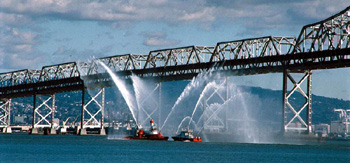|
Week of October 25, 2004 Snapshot from the Field |
LOOKING FOR A PREVIOUS STORY? CHECK THE
ARCHIVE.
Bidding Snag Delays
$5.1-Billion Bay Bridge Project by
JACK LYNE,Site Selection Executive Editor of Interactive
Publishing
The lone bid's value was certainly open to question. The consortium's proposal for building the tower came in at $1.4 billion. That was almost double the state's original $780-million estimate. In like fashion, the project's overall cost has ballooned dramatically since the state's initial 1997 estimate that it would take $1.1 billion to fund the replacement link. The project's current cost estimate stands at $5.1 billion. Those upwardly spiraling expenditures left the state no choice but to reject the tower construction bid. This year's session of the California Legislature adjourned without agreeing on a plan to fund the project's cost overruns.
1989 Quake Collapsed
First opened to traffic in 1936, the Bay Bridge currently
carries an average of 280,000 vehicles a day. The eastern span is being
replaced as part of California's Seismic Retrofit Program for a number
of state-owned bridges. Part of Bridge's East Link The 1989 Loma Prieta earthquake, which measured at 7.0 on the 10-point Richter scale, provided the initial momentum to rebuild the Bay Bridge. The tremor collapsed a portion of the bridge's eastern span, which was built with a cantilevered design. The link's damaged upper deck fell onto the lower deck below it. The bridge was soon repaired and back in use. The extensive damage, though, spurred the state to begin pursuing an upgrade of the structure to meet current seismic standards. The California Department of Transportation (Caltrans at www.dot.ca.gov), which is responsible for the maintenance, operation, and administration of the seven state-owned toll bridges on San Francisco Bay, first conducted a study of the existing east span. The agency's study found that totally replacing the
Construction of the new bridge began in January of 2002. Then-Gov. Gray Davis (D) joined a host of other state and local dignitaries to sign a ceremonial bridge pile on Treasure Island (located next to Yerba Buena Island). "We are beginning construction of what is arguably the safest bridge in the world," Davis said. "This is not just a repair job; this is an investment in California's economy." The Bay Bridge's replacement link - then estimated to cost $2.6 billion - would "also bridge a gap between the 20th and 21st centuries," Davis added at the 2002 ceremony. Within five years, the governor vowed, bridge construction would be complete.
Caltrans Developing Project Re-Bid
That schedule is obviously kaput after the state's rejection of the one tower construction bid. Exactly how the project proceeds from here remains to be seen.
Caltrans will spend the next two months talking with construction industry experts and reviewing current cost figures, McPeak said in Sacramento. The goal, she added, is to come up with a considerably less pricey project. "We have inherited a problem and a series of decisions that cumulatively have resulted in a very complicated design and, as we learned in May, a very expensive one," McPeak explained. The bridge, she contended, can be built for less than $5.1 billion and still be completed by 2012. Caltrans will ultimately develop a re-bid package to present for the Legislature's consideration when state lawmakers reconvene on Dec. 3rd. But McPeak conceded that an award to construct the tower won't come before the summer of 2005. California has also commissioned an independent audit of the span's planning and construction. The state tapped Thomas Hayes, a former state treasurer and director of finance, to spearhead the audit. The
Nonetheless, construction on the skyway portion of the bridge will continue, Caltrans officials explained. That part of the project is 60 percent complete, they said. The first piece of road deck was raised into place on July 27. The replacement span will consist of two five-lane bridge decks sitting side by side. But some foundation work may have to be altered, said McPeak, if the tower design significantly changes in the re-bidding process.
Add $120 Million in Costs But American Bridge CEO Bob Luffy did say that the group has already spent millions of dollars in more than two years of work in its first tower construction bid. The company, he explained, was mulling over whether "to spend good money after bad." Luffy also defended the company's $1.4-billion bid. He described the consortium's projected margins on the project as "pretty thin." In addition, the American Bridge CEO expressed some doubt about how much project costs can really be reduced. Steel prices, he pointed out, have doubled in the last six months. For certain, inflation during the delay in work will increase costs. The bridge tower's tab for construction will increase by $120 million with the added interim of re-bidding the work, according to Caltrans' estimates. A simpler design, though, could substantially lower the tower's total cost, state officials say. "Given where we are at this point and time, and the advice of experts brought in by the [Schwarzenegger] administration to review the entire project, the governor's decision to re-bid is the best way to go," said Jim Wunderman, president and CEO of the Bay Area Council (www.bayareacouncil.org), a business-sponsored public-policy organization made up of the Bay Area's largest employers. Whatever the Bay Bridge replacement's final cost, though, no one at this point knows where funding for the overruns is going to come from. The state seems to think that the local area should pay for the project, with a major chunk of the funding coming through doubling the bridge toll to $4. But some local area leaders are contending that the state should shoulder part of the price tag.
PLEASE VISIT OUR SPONSOR • CLICK ABOVE 
Site
Selection Online
| ||||||||||||||




